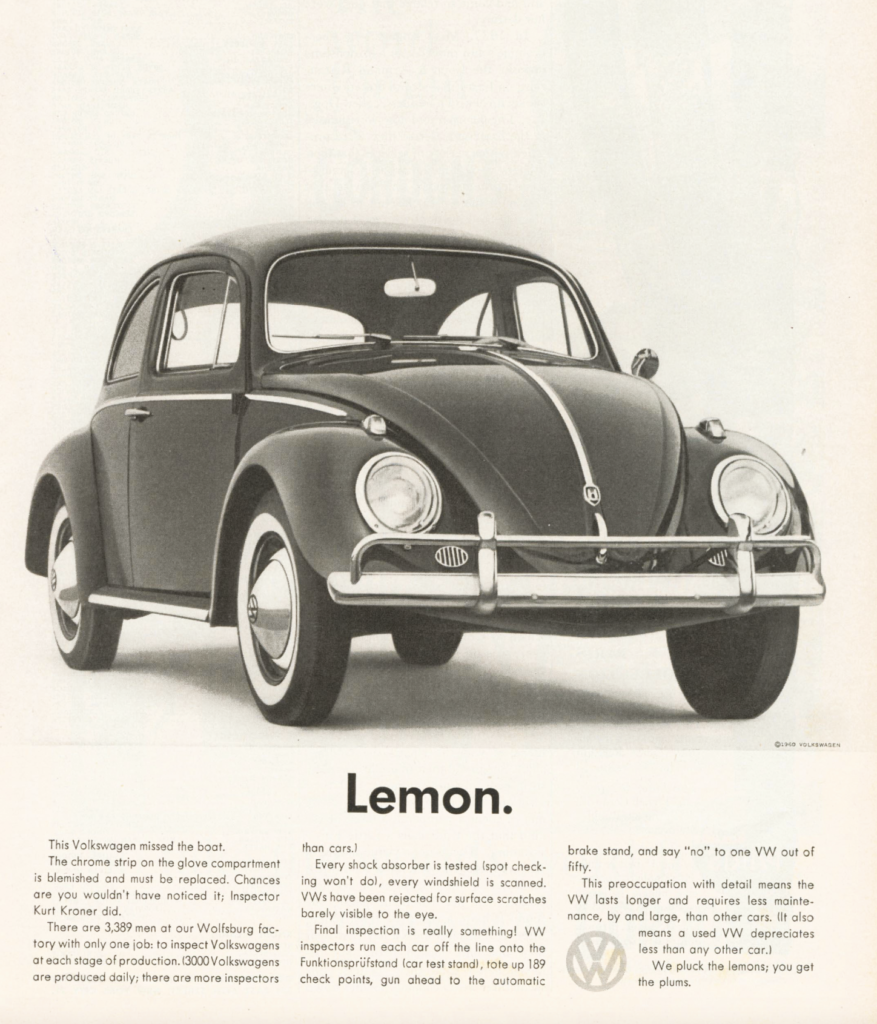Advertising agencies need a paradigm shift to put the focus of their work back where it should be: their impact on clients’ sales.
In 1959, Bill Bernbach of Doyle Dane Bernbach (DDB) shook the advertising industry by introducing a new paradigm: creative advertising. The theory was that advertising should become highly creative, ironic, entertaining and simple.
Previously, advertising agencies bludgeoned consumers with hard-sell ads that followed the unique selling proposition (USP) concept developed by Rosser Reeves – “buy this product, and you will get this specific benefit.” The message was repeated, over and over, pounding its way into consumers’ heads. But by the end of the 1950s, times were changing. Consumer spending and corporations were growing strongly, television was asserting its place in 90% of US households, and 45% of the US population was aged 24 or younger.
The creative testing ground for Bernbach’s paradigm was Volkswagen Beetle advertising. The 1959 VW ads, and the 1962 Avis ads created by DDB, set simple design standards and established the primacy of creativity that has endured to the present day. The media coined the phrase ‘the creative revolution’ to describe the switch to whimsical ‘big ideas’ and simple designs that was initiated in 1959, and Bernbach became a creative guru for the industry.
But Bernbach’s views on the purpose of advertising were forgotten by subsequent generations of creative executives. “The purpose of advertising is to sell,” he said. “That is what the client is paying for, and if that goal does not permeate every idea you get, every word you write, every picture you take, you are a phony and you ought to get out of the business.”
His message was pithy. “Our job is to sell our clients’ merchandise… not ourselves. Our job is to kill the cleverness that makes us shine instead of the product. Our job is to simplify, to tear away the unrelated, to pluck out the weeds that are smothering the product message.”
These commercial warnings were ignored, overwhelmed by the industry’s interest in showing off its creative chops. Advertising’s misplaced emphasis on creativity continues to this day.
Creativity run amok
The most egregious examples of creativity run amok were the creative ads of Burger King in the years after 2010. In 2023, the highly respected World Advertising Research Center (WARC), identified Burger King as the number one brand for creativity. In fact, it topped WARC’s brand table for the fifth year in a row. The only problem with this award is Burger King’s chronically poor long-term sales performance. Between 2010 and 2021, Burger King was one of the slowest-growth, marginal performers in the fast food category. In 2021, its sales per restaurant were only $1.4 million, woefully behind McDonald’s ($3.4 million) and Chick-fil-A ($6.1 million), according to analysis by Farmer & Company for industry title QSR Magazine.
If low sales per store is Burger King’s fundamental problem, one wonders how its award-winning Moldy Whopper ad, designed to highlight the burger’s ‘all natural’ ingredients, ever saw the light of day. Yet Moldy Whopper scooped multiple industry awards, including a Gold Lion in the outdoor category at the 2020 Cannes Lions International Festival of Creativity.
The bigger point is that Burger King is not the only major advertiser with growth problems. Between 2009 (after the global financial meltdown) and 2019 (before Covid-19 disruption), 20 of the top 50 advertisers in the US had, collectively, negative growth in sales for this decade. Their massive investments in digital and social advertising, plus their focus on ‘creativity,’ did not do much for client sales.
Advertising agencies have seen their creative workloads grow and their fees decline during this period, and they are routinely fired by their clients after three years of work. Clients pay agencies ‘by the head’ rather than for the work they do, while the owners of agencies – the communications holding companies – insist that agencies downsize if necessary to make their numbers in the face of declining fees. Agencies are caught between fee-cutting clients and profit-hungry owners.
A new results paradigm
The advertising industry needs a new paradigm that reinforces Bill Bernbach’s admonition that the purpose of advertising is to sell, not to be recognized for the cleverness of its ads. What would an agency results-paradigm include? There are at least six crucial factors.
- An agency mission statement that an agency is 100% dedicated to helping clients improve their commercial and competitive performance.
- An analytical approach that identifies the client performance problems to be solved before any creative work is begun. Creative work should solve performance problems.
- A statement that creativity is only one of many agency capabilities that need to be mobilized on behalf of clients.
- A relationship philosophy that seeks ‘partnerships for performance improvements’ rather than ‘vendorships to do client work at the lowest fee possible’.
- Client longevity rather than new client wins as a measure of agency success. The pursuit of creative awards should be significantly downgraded or eliminated.
- A revised remuneration approach that sees agencies paid for the work they do, rather than for the number of people assigned to their accounts.
The adoption of a revised paradigm – a results paradigm to replace the current creative paradigm – will require the leadership and commitment of agency CEOs. Are they up to the task? If not, then agencies are certain to continue their decline, making it difficult to recruit and retain the necessary talent. And they will see their workloads migrate to AI and their strategic tasks given to consulting firms. No ‘Mad Man’ in his right mind would want this to happen.
Michael Farmer is professor of branding and integrated communications at The City College of New York and author of Madison Avenue Makeover (LID Publishing, 2023).



